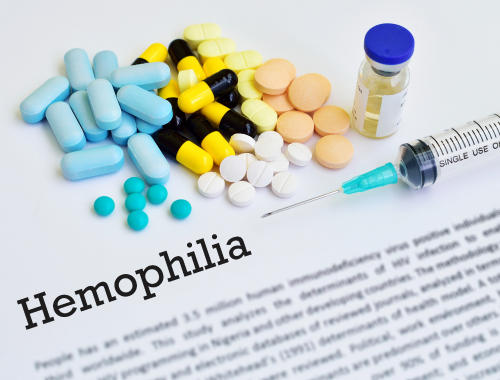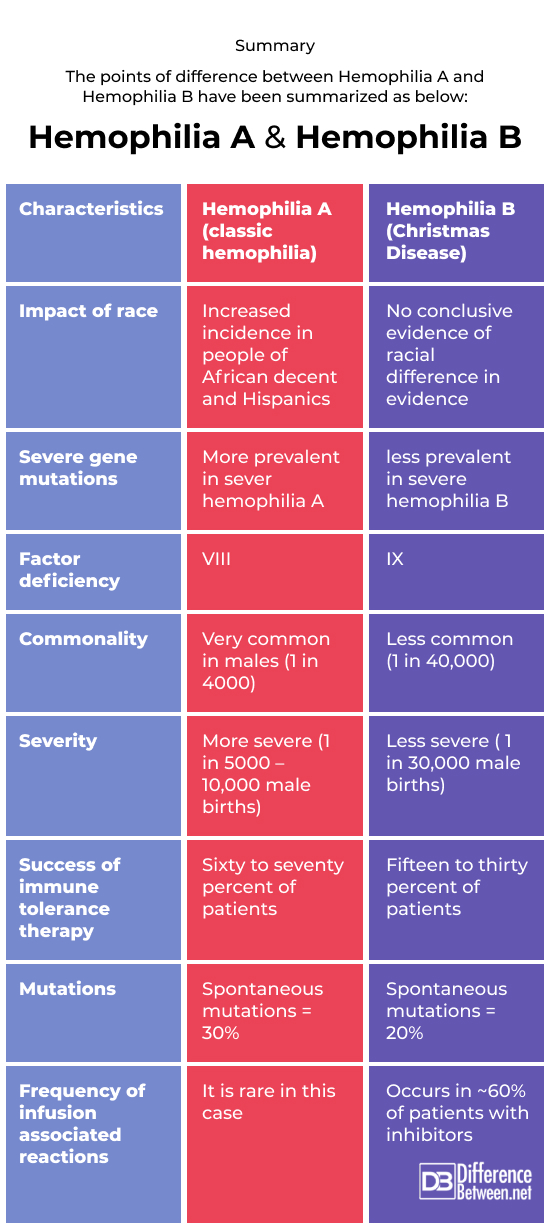Difference Between Hemophilia A and Hemophilia B

What is the difference between hemophilia type A and B?
Hemophilia is an inherited blood disorder. It has three types – Hemophilia A, Hemophilia B and Hemophilia C. Hemophilia A (classical hemophilia) is a factor VIII deficiency, hemophilia B (Christmas disease) is a factor IX deficiency. The most prevalent kind of hemophilia is hemophilia A. It occurs when there is insufficient clotting factor 8 (factor VIII). According to the CDC (Centers for Disease Control and Prevention), hemophilia A affects roughly 10 in every 100,000 persons. Hemophilia B is a condition where there is insufficient clotting factor 9 (factor IX).
Both types are the result of mutations in the genes (a change to a gene’s DNA sequence to produce something different) that encode coagulation factors (proteins in your blood) that bring down bleeding. The difference is in the affected proteins.

Similarity
Both share similar symptoms and signs and inheritance pattern
Hemophilia A
It occurs when there is insufficient clotting factor 8 (factor VIII).
Hemophilia B
Hemophilia B is a condition where there is insufficient clotting factor 9 (factor IX).
Difference between hemophilia type A and B
Definition
Hemophilia A
In hemophilia A, there is insufficient coagulation factor VIII. In rare situations, hemophilia A can be acquired during life from an auto-antibody (an antibody developed by the immune system against person’s own proteins) to factor VIII.
Hemophilia B
In hemophilia B, there is absence or insufficient coagulation factor IX.
Hemophilia Prevalence
Hemophilia A
Hemophilia A is more common in comparison to hemophilia B. According to CDC, there are twelve cases per 100,000 men for hemophilia A.
Hemophilia B
Hemophilia B is less common in comparison to hemophilia A. According to CDC, there are three and a half cases per 100,000 men for hemophilia B.
Hemophilia symptoms
Hemophilia A
- regular prophylaxis
- bleeding is more frequent
Hemophilia B
- regular prophylaxis not needed
- bleeding is less frequently
Causes
Hemophilia A
It is caused by the disruptions or mutations to the F8 gene present on the X chromosome.
Hemophilia B
It is caused by defective or missing factor IX, a clotting protein. It is caused by disruptions to the F9 gene present on the X chromosome
Treatment
Hemophilia A
Treatment with factor VIII replacement. Immune tolerance induction is successful in about seventy percent of people with hemophilia A
Hemophilia B
Treatment with factor IX replacement. Immune tolerance induction is successful in about thirty percent of those with hemophilia B.
Summary
The points of difference between Hemophilia A and Hemophilia Bhave been summarized as below:

FAQ:
What is the difference between hemophilia A and B and C?
When a person gets a defective gene from one of their biological parents, they develop hemophilia A and hemophilia B. People with hemophilia C may receive defective genes from both of their biological parents. People with hemophilia C do not experience bleeding problems that impair their joints or muscles, in contrast to those with hemophilia A or B. Hemophilia A (classical hemophilia) is a factor VIII deficiency, hemophilia B (Christmas disease) is a factor IX deficiency, and hemophilia C (Rosenthal syndrome) is a factor XI deficiency.
Is hemophilia B more severe than hemophilia A?
Hemophilia A is more severe in comparison to hemophilia B
Why is hemophilia B called Christmas disease?
Hemophilia B is also termed as ‘Christmas disease’ after the first patient was affected by this disorder back in 1952.
Did Queen Victoria’s sons have hemophilia?
Queen Victoria’s son – Prince Leopold born on April 7, 1853 was her only son affected by disease hemophilia. Her two daughters became the carriers of hemophilia and passed on this disorder to German, Russian and Spanish royalties.
Can a female have hemophilia A or B?
Hemophilia can also affect females; however, this is far less common. Both X chromosomes are defective, or one is diseased and the other is absent or non-functional, in women who have hemophilia. These girls’ bleeding symptoms may resemble those of hemophiliac males.
Can females have hemophilia B?
It is more common in males. However, females can be carriers of hemophilia B and may show some signs of bleeding.
- Difference Between Global Warming and Greenhouse Effect - May 18, 2024
- Difference Between Vaccination and Immunization - March 3, 2024
- Difference Between Selective Mutism and Autism - February 25, 2024
Search DifferenceBetween.net :
Leave a Response
References :
[0]Goodeve, A. C. (2015). Hemophilia B: molecular pathogenesis and mutation analysis. Journal of Thrombosis and Haemostasis, 13(7), 1184-1195.
[1]Franchini, M., Gandini, G., Di Paolantonio, T., & Mariani, G. (2005). Acquired hemophilia A: a concise review. American journal of hematology, 80(1), 55-63.
[2]Franchini, M., & Mannucci, P. M. (2013). Hemophilia A in the third millennium. Blood reviews, 27(4), 179-184.
[3]George, L. A., Sullivan, S. K., Giermasz, A., Rasko, J. E., Samelson-Jones, B. J., Ducore, J., ... & High, K. A. (2017). Hemophilia B gene therapy with a high-specific-activity factor IX variant. New England Journal of Medicine, 377(23), 2215-2227.
[4]Konkle, B. A., & Fletcher, S. N. (2022). Hemophilia a. GeneReviews®[Internet].
